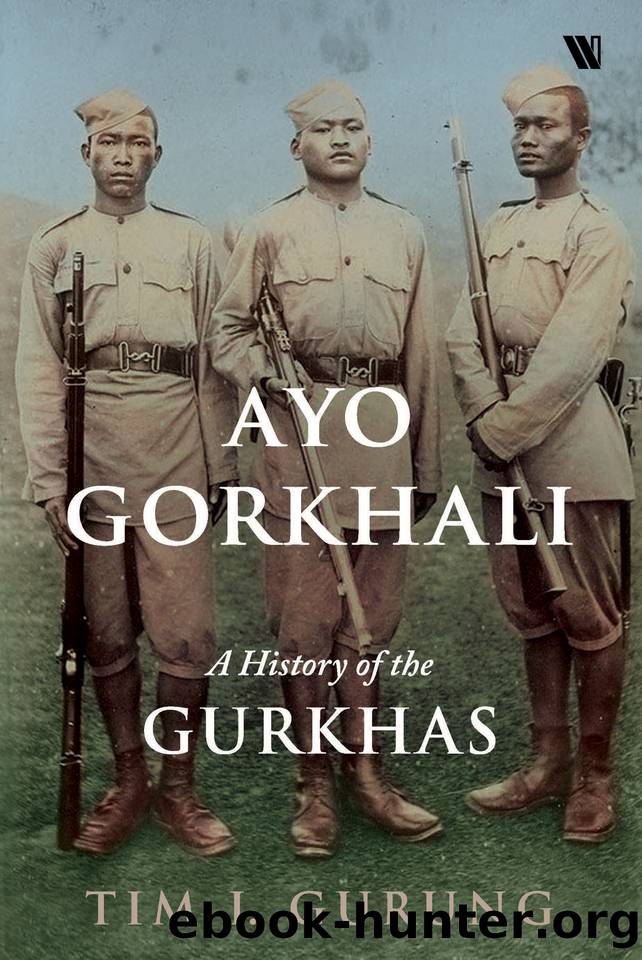Ayo Gorkhali: A History of the Gurkhas by Gurung Tim I

Author:Gurung, Tim I. [Gurung, Tim I.]
Language: eng
Format: epub
Published: 2020-11-15T16:00:00+00:00
2nd phaseâThe Memorial Museum
3rd phaseâThe Nepali Cultural Village
4th phaseâThe Tower
5th phaseâThe Gurkha Rail
By building this park, Padam Bahadur wants the world to know about the 200-year-old Gurkha history and be aware of the irreparable losses the Gurkhas, as well as Nepal as an independent country, have suffered, and eventually change the worldâs perception towards Nepal and its people.
I visited this location during my Nepal trip in 2018 but was disheartened to witness the actual state of the project. I genuinely thought that Padam Bahadur had been too ambitious. The whole place looked abandoned. Not much has been done since the initial construction, and Padam Bahadur looked somewhat like a defeated man, although he tried to appear as enthusiastic, passionate and driven as he was during the first meeting just a year ago. The provincial government of Nepal is now funding the project, a budget of five to six crore rupees was supposedly arriving soon, and Padam Bahadur was hoping to finish the project (not the whole but only phase 1 of the project) by the next year (2019). He also explained that the local leaders have already understood the importance of the project and they have more than enough incentive to complete the whole project. But I could see the pain in his face while he was explaining the situation to me. Given the nature of Nepali politics, I couldnât help but feel sorry for him. The chances of his pet project being hijacked by Nepali leaders was more than real. Even so, if the project is somehow completed shortly, it will still be a great achievement for him as well as the whole Gurkha community. 7
By the first quarter of 2018, most of the major players of the Gurkha campaign had united for good, and a complete dossier on ex-Gurkha grievances prepared by the team had been presented to the ministry of defence. It covered Gurkhasâ pay, pension, human rights, medical facilities, fairness and equality, national insurance and legality issues. According to the report by CNSUK, approximately 22,000 ex-Gurkhas and widows are still treated unequally in comparison to their British counterparts on pension; 6,534 Gurkhas were made redundant between the period of 1948-1975 with no pension and 3,438 that were identified as poor receive a welfare pension from the Gurkha Welfare Trust. Five hundred and forty-two Gurkhas discharged after 1975 do not receive any allowances.
Noticeably, the participation of the Nepali Embassy in the Gurkha cause was noteworthy, and the chance of finding a solution had improved. The campaigners also presented a detailed report on Gurkhasâ grievances to the PM of Nepal, K.P. Oli, in Kathmandu by April 2018, and hoped for the Nepal government to help support their cause and understandably initiate bilateral talks with the British government.
The decision by the ministry was still to be made and by the time the book went to press, the talks on Gurkhasâ equal rights were still going on.
The actual announcement of 21 May 2009 opened new horizons for the Gurkhas and their families.
Download
This site does not store any files on its server. We only index and link to content provided by other sites. Please contact the content providers to delete copyright contents if any and email us, we'll remove relevant links or contents immediately.
| Africa | Americas |
| Arctic & Antarctica | Asia |
| Australia & Oceania | Europe |
| Middle East | Russia |
| United States | World |
| Ancient Civilizations | Military |
| Historical Study & Educational Resources |
The Third Pole by Mark Synnott(679)
Money for Nothing by Thomas Levenson(627)
Christian Ethics by Wilkens Steve;(571)
The Economist (20210109) by calibre(566)
Made in China by Anna Qu(540)
100 Posters That Changed The World by Salter Colin T.;(498)
Reopening Muslim Minds by Mustafa Akyol(485)
Routledge Handbook of Contemporary India by Knut A. Jacobsen(477)
The Irish Buddhist by Alicia Turner(473)
Nonstate Warfare by Stephen Biddle(466)
Culture by Terry Eagleton(461)
The Great Pyramid Void Enigma by Scott Creighton(451)
The Age of Louis XIV: The Story of Civilization by Will Durant(440)
Ideology by Eagleton Terry;(436)
The Shortest History of China by Linda Jaivin(432)
Objects of Vision by Saab A. Joan;(426)
Banaras: CITY OF LIGHT by Diana L. Eck(424)
The Jews of Silence: A Personal Report on Soviet Jewry by Elie Wiesel(422)
Sybille Bedford by Selina Hastings(411)
